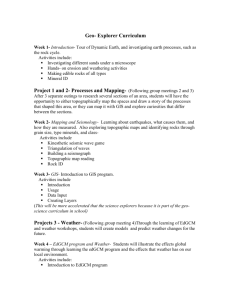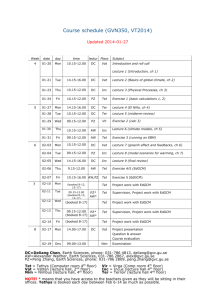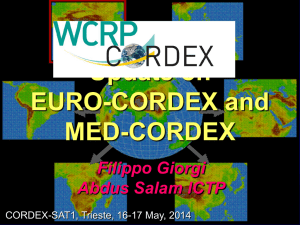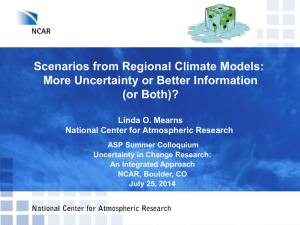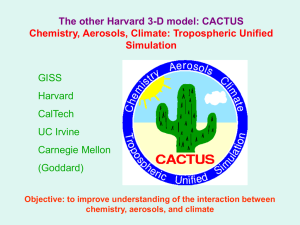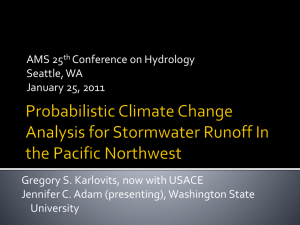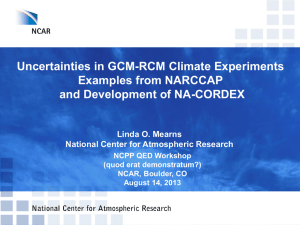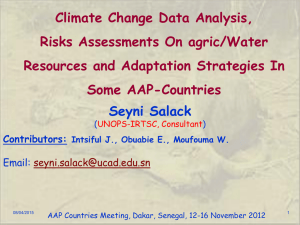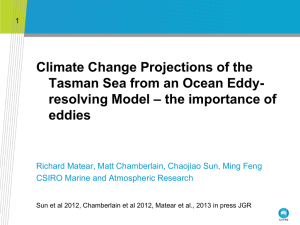EdGCM Presentation - Columbia University
advertisement
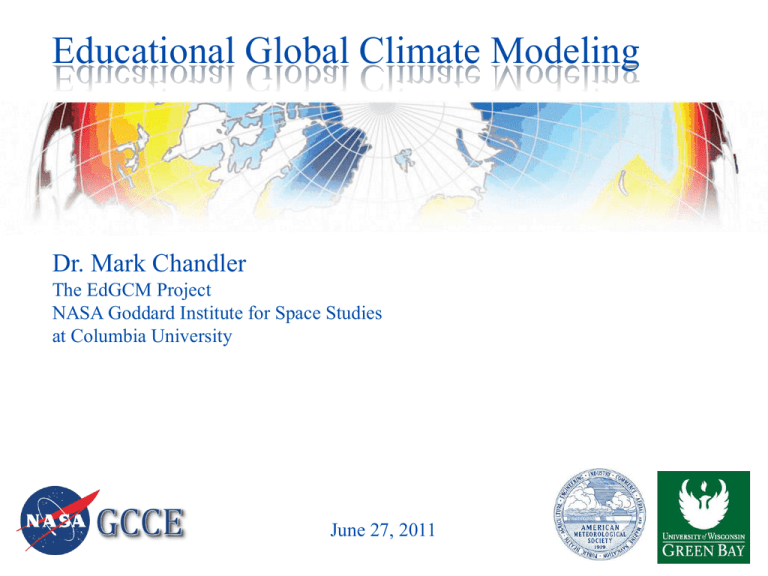
Educational Global Climate Modeling Dr. Mark Chandler The EdGCM Project NASA Goddard Institute for Space Studies at Columbia University June 27, 2011 EdGCM-AMS/UWGB June 2011 Workshop This presentation contains animations and must be viewed using PowerPoint presentation mode. All contents are copyright Columbia University, 2011 NASA’s Goddard Institute for Space Studies (GISS) EdGCM Project Objectives Allow teachers and students to run a full research version of a global climate model on desktop and laptop computers Encourage students to participate in the full scientific process • Experiment design • Running simulations • Analyzing data • Reporting on results Facilitate collaborations between schools, universities, national labs, and the private sector so students become familiar with the role of teamwork in scientific research. …and by doing the above demystify how scientists forecast climate change. What is a GCM? Global Climate Model Physical Processes Simulated by GCMs Seasonal and Diurnal Cycles Latent and Sensible Heat Fluxes Clouds and Convection Planetary Boundary Layer Greenhouse Gases Aerosols Sea Ice Ground Hydrology Ocean Heat Transport Ocean Circulation Dynamic Vegetation Dynamic Ice Sheets Carbon Cycle Chemistry Tools of the Trade: Global Climate Models Fundamental Physical Equations: (Henderson-Sellers, 1985) Increased Resolution Requires Increased Grid Resolution Increased Computing Resources Requires Increased Computing Power 1980’s (EdGCM) 1990’s Rule of thumb: 10X more CPU for a doubling of resolution 2000’s But, What Is a GCM really? Global_Warming_Sim2.R Model II 8/24/2000 Owner: Dr. Mark Chandler, chandler@giss.nasa.gov Group: Paleoclimate Group This experiment simulates climate change based on a 1 percent/year increase in CO2 Object modules: MainC9 DiagC9 RadC9 FFTC9 UTILC9 Data input files: 7=G8X10_600Ma 9=NOV1910.rsf_snowball 15=O8X10_600Ma 19=CD8X10_600Ma 23=V8X10_600Ma 26=Z8X101_600Ma 21=RTAU.G25L15 22=RPLK25 29=Snowball_Earth_Regions C** INITIALIZE SOME ARRAYS AT THE BEGINNING OF SPECIFIED DAYS fName = './prt/'//JMNTH0(1:3)//CYEAR//'.prt'//LABEL1( IF(JDAY.NE.32) GO TO 294 JEQ=1+JM/2 DO 292 J=JEQ,JM DO 292 I=1,IM 292 TSFREZ(I,J,1)=JDAY JEQM1=JEQ-1 DO 293 J=1,JEQM1 DO 293 I=1,IM 293 TSFREZ(I,J,2)=JDAY GO TO 296 294 IF(JDAY.NE.213) GO TO 296 JEQM1=JM/2 DO 295 J=1,JEQM1 DO 295 I=1,IM 295 TSFREZ(I,J,1)=JDAY C**** INITIALIZE SOME ARRAYS AT THE BEGINNING OF EACH DAY 296 DO 297 J=1,JM DO 297 I=1,IM A COMPUTER PROGRAM Requiring significant computing skills and resources to operate Label and Namelist: Global_Warming_Sim2 (Transient increase in CO2) &INPUTZ TAUI=10176.,IYEAR=1900, KOCEAN=1, SRCOR=.95485638151, S0X=1.,CO2=.31746031746031, USET=0.,TAUE=35040., USESLP=-12., ISTART=3,KCOPY=2,NDPRNT=-1,TAUE=10177.,TAUP=95616., TDIURN(I,J,1)=1000. TDIURN(I,J,2)=-1000. TDIURN(I,J,6)=-1000. PEARTH=FDATA(I,J,2)*(1.-FDATA(I,J,3)) IF(PEARTH.GT.0.) GO TO 297 TSFREZ(I,J,1)=365. TSFREZ(I,J,2)=365. 297 CONTINUE GCMs should be in common use “…Very soon it will be possible to run a GCM on a laptop computer.” But, it never “GCMs will begin runninghappened…why? on workstations in high schools, and possibly elementary schools. They may even be running in the offices of congressman.” Dr. David Randall Bulletin of the American Meteorological Society, 1996 What is EdGCM? A GLOBAL CLIMATE MODEL • The NASA/GISS GCM Model II A GRAPHICAL INTERFACE wrapped around the climate model, a database, and data analysis tools to make it easier to: • • • OPERATE the climate model ORGANIZE the data DISPLAY the results (scientific visualization) Other Computer Code Wrappers BLUE ICE: NCAR - Boulder, Colorado EdGCM Set up, Run and Organize EdGCM Analysis and Visualization Post-process all of the binary GCM output (hundreds of climate variables) Allow teachers to define variable sets Scientific Visualization Color and contour maps Line plots Data spreadsheets The EdGCM Websites Download Software and Materials Support and Discussion Forums Community and Student Showcases Video Tutorials and Manuals EdGCM Creating Reports and Publishing Image Libraries eJournals Web-based Publishing Distribution Over 40,000 copies in distribution, on 7 continents edgcm.columbia.edu • Extra slides follow >>>>>>>>> Global Climate Change: ClimateComing Change is Here Soon to a Community Near You 4X increase in western U.S. wildfires in 30 years IGCCE
